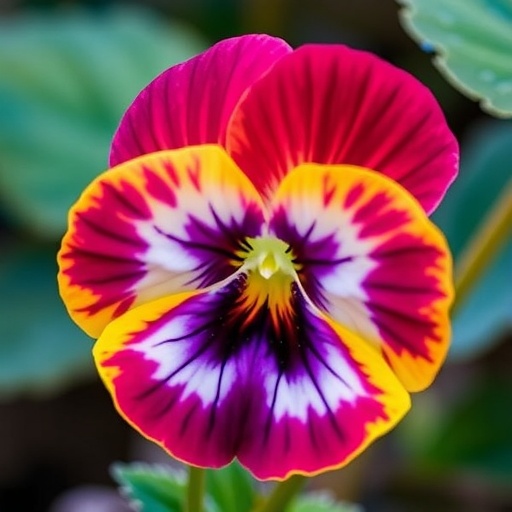
In a groundbreaking study published in the prestigious journal New Phytologist, researchers from Kindai University, Japan, have unveiled the genetic and molecular underpinnings behind the striking color patterns seen in African violet flowers (Streptocarpus sect. Saintpaulia ionanthus). This meticulous investigation deciphers the origin of white-striped pigmentation, a varietal hallmark previously misunderstood, revealing how a single gene, SiMYB2, orchestrates complex anthocyanin depositions responsible for the flower’s vibrant hues.
Flowers have long captivated human fascination, not only serving as essential agents in plant reproduction but also bearing rich emotional and cultural symbolism. The African violet, an ornamental species cherished worldwide, is notable for its intricate petal designs, predominantly shaped by anthocyanin pigments. These pigments impart a range of colors from deep purples to delicate pinks, but the phenomenon of white-striped petals — characterized by clear demarcations between pigmented and non-pigmented areas — has puzzled scientists for decades.
Historically, the prevailing theory posited that these white-striped petals arose from periclinal chimeras, where genetically distinct cell layers nestle within different strata of the petal, resulting in varied coloration. However, emerging evidence from genetic studies in chrysanthemums questioned this model, pointing instead to transcriptional regulation of pigment-related genes as a driver of floral coloration. Inspired by this, the Kindai University team set out to explore whether selective gene expression rather than chimerism dictated the unique pigmentation patterns in African violets.
.adsslot_VeFJU6cNgP{width:728px !important;height:90px !important;}
@media(max-width:1199px){ .adsslot_VeFJU6cNgP{width:468px !important;height:60px !important;}
}
@media(max-width:767px){ .adsslot_VeFJU6cNgP{width:320px !important;height:50px !important;}
}
ADVERTISEMENT
The research group, led by Professor Munetaka Hosokawa, designed an experiment using tissue culture propagation techniques to generate African violet specimens with divergent petal colors: pure pink, pure white, and the characteristic white-striped forms. Observing these regenerated plants illuminated a key phenomenon of unstable anthocyanin accumulation, manifesting as randomly dispersed pigmentation even within genetically identical tissue. Flavonoid profiling further emphasized this disparity, showing enriched flavonoid compounds in pink petals but markedly decreased levels in white petals.
Advancing their analysis, the scientists performed comprehensive genome sequencing, which uncovered suppression of critical anthocyanin biosynthesis genes (ABGs) within white petal tissues. To isolate the molecular trigger behind this suppression, the team employed quantitative reverse transcription polymerase chain reaction (qRT-PCR), allowing precise measurement of gene expression levels, alongside phylogenetic assessments of candidate transcription factors. This multifaceted approach identified two genes, SiMYB2 and SibHLH2, as prime candidates influencing pigmentation variability.
Focusing on DNA methylation—a key epigenetic modification regulating gene activity—the investigators noted that differential methylation of SiMYB2 correlated with unstable pigment deposition. Intriguingly, SiMYB2 was found to produce two discrete mRNA variants through alternative transcription: a longer form (SiMYB2-Long), predominantly expressed in pigmented petals, and a shorter form (SiMYB2-Short), exclusive to non-pigmented areas. These isoforms differentially regulate the activation of anthocyanin biosynthesis pathways, leading to the unique striped petal phenotype.
This dual-transcript mechanism introduces a new paradigm in understanding floral color patterning, challenging traditional views that attribute visible phenotypes solely to genetic mosaics. Instead, the study highlights how selective transcriptional activity of a single gene can produce spatially regulated pigmentation patterns with remarkable precision, potentially influenced by epigenetic landscapes shaped during tissue culture propagation.
Professor Hosokawa reflects on the broader implications of the findings, emphasizing that the domestication and selective breeding of flowers have historically harnessed such genetic mechanisms, though largely unrecognized until now. “Our research opens doors to deliberate manipulation of floral aesthetics at the genetic level,” he notes, envisioning a future where breeders may harness transcriptional selectivity to customize flower patterns with unprecedented control and consistency.
Moreover, the study illuminates potential applications beyond ornamental breeding. Understanding the molecular governance of anthocyanin distribution may inform strategies for enhancing stress responses or nutritional value in plants, given anthocyanins’ roles in antioxidative defense and health benefits. The revelation that a single MYB gene can toggle pigment patterns adds a valuable tool to the broader field of plant molecular biology and genetics.
While the current research employed tissue culture and epigenomic profiling as investigative tools, it also underscores the necessity for integrative methods incorporating transcriptomics, methylomics, and functional genomics to unravel complex phenotypic traits. The authors anticipate that ongoing advancements in genome editing and single-cell analysis will further elucidate the spatiotemporal dynamics of gene regulation in flower development.
As floral research progresses over the next decade, the genetic basis of pattern formation is likely to become clearer, heralding a new era in horticulture where diverse and elaborate flower designs can be engineered through precise modulation of regulatory genes. Ultimately, this study stands as a pioneering example of how detailed molecular scrutiny can decode the elegant artistry of nature’s palette.
—
Subject of Research: African violet flower pigmentation and pattern formation mechanisms
Article Title: Unstable anthocyanin pigmentation in Streptocarpus sect. Saintpaulia (African violet) is due to transcriptional selectivity of a single MYB gene
News Publication Date: August 1, 2025
References: DOI: 10.1111/nph.70286
Image Credits: Prof. Munetaka Hosokawa, Kindai University, Japan
Keywords: Plant sciences, Genetics, Agriculture, Horticulture, Molecular biology, Genomics, Anthocyanin pigmentation, Floral patterning, Transcriptional regulation, Epigenetics, MYB transcription factors, Streptocarpus sect. Saintpaulia
Tags: advancements in plant scienceAfrican violet color patternsanthocyanin pigmentation in flowersflower color geneticsgenetic basis of flower colorationmolecular biology of flower pigmentationornamental plant researchplant genetics and floral designSiMYB2 gene functionStreptocarpus sect. Saintpaulia ionanthustranscriptional regulation in plantswhite-striped African violets





